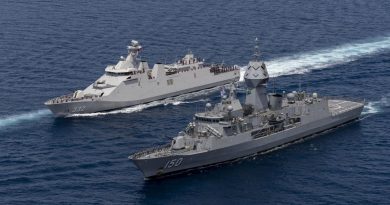Engaging Brunei’s perspective

Maritime security law has proved a rich topic for Australia and Brunei to discuss common interests during the latest iteration of Indo-Pacific Endeavour 2023 (IPE23).
CAPTION: Paying respects at the Brunei-Australia War Memorial at Muara Beach during Indo-Pacific Endeavour 2023. Story by Squadron Leader Eamon Hamilton. Photos by Corporal Dan Pinhorn.
Australia’s flagship regional engagement activity returned to Brunei from July 29 to August 3, and included key leadership meetings led by Head of Navy Engineering Rear Admiral Rachel Durbin.
Rear Admiral Durbin also shared her career experience and perspectives on leadership in a seminar with more than 40 servicewomen of the Royal Brunei Armed Forces.
A two-day maritime security law forum at the Royal Brunei Defence Academy also allowed Royal Australian Navy legal officers to build a deeper appreciation of Bruneian perspectives.
Led by Commodore Rob McLaughlin, the forum comprised topic briefings and a series of scenario-based syndicate discussions.
“We’ve discussed topics where we can share perspectives, including the United Nations Law of the Sea Convention, rules around peacekeeping operations and the use of force, and maritime law enforcement powers,” Commodore McLaughlin said.
Brunei has a total population of 460,000, and is located on the north of the island of Borneo with its coastline on the South China Sea.
Maritime security forms an important part of Australia’s defence engagement with Brunei, extending back to amphibious landings in Brunei in June 1945 under Operation Oboe VI.
Eight decades on, IPE23 provided an opportunity for Rear Admiral Durbin and Navy legal officers to pay their respects at a war memorial on Muara Beach, which was the site of the landings.
IPE23’s maritime security forum explored how modern nations managed issues such as policing their Exclusive Economic Zones and upholding their sovereignty.
Beyond members of the Royal Brunei Armed Forces, the forum included representatives from other Brunei government departments, including police, customs and policy agencies.
“That really indicates an interest in ‘joined-up’ operational thinking, and joint legal thinking in supporting operations,” Commodore McLaughlin said.
“There’s a really high level of understanding that maritime issues and operations are not just for the Navy – they’re actually whole-of-government issues and require whole-of-government responses.”
The use of military law as an engagement tool during this year’s IPE provided a means for Brunei and Australia to understand how each nation approaches maritime operations.
“It’s something that is common among armed forces, and certainly is something that is common among armed forces that share a certain legal heritage,” Commodore McLaughlin said.
“We can share our approaches and find where the common grounds are, and also understand the different perspectives.
“If ever we’re in a situation where we need to talk with our Brunei colleagues, we can do so while understanding each other’s perspectives better.”
The wider program for IPE23 will engage 14 nations, including Brunei, and involve personnel from the Royal Australian Navy, Australian Army and Royal Australian Air Force.
Commander IPE23 Air Commodore Tony McCormack said he was excited for Australia to grow its long-standing defence partnership with Brunei.
“Australia and Brunei have a shared interest in a peaceful, secure and prosperous Indo-Pacific region, with ASEAN [Association of Southeast Asian Nations] at its centre,” Air Commodore McCormack said.
“The elevation of Australia and Brunei’s bilateral relationship to a Comprehensive Partnership, with Defence as a core pillar, is an exciting milestone.”
Signed in June, the Comprehensive Partnership articulates shared aspirations across areas including respect for international law, sovereignty and working together on maritime security.
That same month, His Excellency Sultan Haji Hassanal Bolkiah, the Sultan of Brunei, visited the Northern Territory, where he had the opportunity to meet with Australian Defence Force personnel.
.
.

.
.





